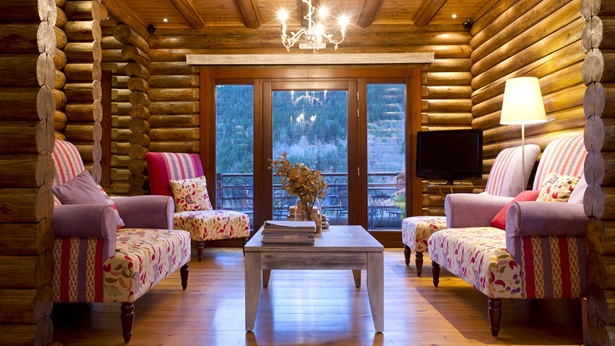Log Home Industry Basics
Since you’re investing your life savings into this decision, it’s wise to understand how the industry operates. That’s why we created The Perfect Path To Your Dream Home, to provide consumers with a map of the buying and building process.
Log and timber homes have come along way from their pioneer beginnings. Today’s homes are crafted with precision, using modern milling methods. Manufacturers sell their homes in a variety of ways. This can include:
- In-house representatives directly employed by a log and timber home manufacturer
- Builder/dealers who are self-employed independent sales agents
- Builders or contractors who are independent sales agents but also build homes
In-house Representatives
Typically these individuals work from a log and timber home company’s office. They have a broad knowledge of design, engineering, construction, costs and building conditions over a wide area. They most likely live in a log and timber home, so they understand your motivation for wanting a log and timber home of your own. They also have easy access to design and estimating services. They are usually available during the day, Monday through Friday.
Builder/Dealer
These are an independent authorized agent for a log and timber home company and this may be their full-time gig or a part-time passion. Many builder/dealers go into the business because they built their own home and they liked the process so much, they help others realize their dream of log and timber home ownership. The advantage of working with someone local is that they will have detailed knowledge of building conditions and costs in your local market. Builder/dealers can work from a home office, a model home or a retail location. They communicate your needs to the log and timber home manufacturer through emails, websites, phone and fax.
Log Home Builder or Contractor
These self-employed individuals often have the greatest knowledge of log and timber home construction because it’s what they do on a daily basis. They are problem solvers. Often in the field, builders also work from a retail location or a home office. Your best bet for reaching these individuals is by cell phone. But you can also reach a builder through fax, phone, mail and computer communications. Sometimes they are less available during the day because of they are working at construction sites.
What Are My Choices in Logs or Timbers?
To start, there are more than 17 common tree species used in the log and timber home industry, each with its own unique properties — grain pattern, color, size (diameter and length), thermal performance and resistance to decay. Plus, logs can be fashioned into a host of different corner styles and profiles, using different fastening and sealant systems. Vying for your business are more than 400 companies in the United States and Canada. These companies range from small mom-and-pop shops to large-scale, multi-state operations. Obviously with so many candidates, you’ll have to narrow the field.
Discover What Styles Delight You
Since many companies specialize in one particular style, the process of elimination should start with what you find attractive. Here’s how to tell the styles apart:
- Manufactured or milled: This is how the vast majority of log and timber homes are constructed today, accounting for a full 90% of the market. Logs are milled to a specific profile (D-log, round log, etc.) and precut to fit a particular home design. Identify these by the uniform diameters on the corner profiles.
- Handcrafted: These custom homes account for 10% of all log and timber homes constructed annually. Detect these by noticing larger logs with varying diameters at corners or a hand-hewn appearance.
- Half-log: This log siding is applied over conventional 2-by-4 or 2-by-6 framing. To maintain the illusion of full log, the corners sections can be full log. Log siding is often used for second story applications or for garages or outbuildings.
- Timber Frame: Also known as post and beam, this style includes large horizontal or vertical beams on the interior. Beams can either be handcrafted or milled.
There’s a System to This Form of Construction
Today’s modern log and timber homes involve a “building system,” combining engineering principles with specific crafting, sealing and fastening techniques for a specific tree species. As you shop companies, ask if their building system is recognized by your local building code. Will an engineer’s stamp be required for approval by the local building department and if so, at what cost?
Construction Service
A few companies offer “shell construction,” where a producer’s own crews will dry-in the structure, which means make the shell weather tight. Still others companies may offer full “turnkey” construction. But the majority of members of the Log and Timber Homes Council leave it to independent builders or contractors to complete the home on your land.
Do They Belong to the Log and Timber Homes Council?
If you are looking for peace of mind during this process, look no further than the Log and Timber Homes Council (LTHC) of the National Association of Home Builders, which sponsors this website. The LTHC requires all member companies adhere to a strict code of ethics, grade logs using a third party service, furnish builders with a construction manual and contribute to scientific research to advance log building technologies.
What’s in the “Package?”
Your dream home will begin as a “log and timber home package.” This is the two or three truckloads of logs and other components that will create your home, which are delivered to your building site. However, not all packages are created equal. That’s why you should only entrust the members of the LTHC with your dream home. These reputable companies list all the materials they provide, including interior walls, floors, cabinets, hardware, windows, doors and more.
Flexible Packaging
Want to buy some materials locally? It’s not a problem. Members of the LTHC offer several different options on the completeness of packages, to serve your individual needs. To start shopping for log and timber home producers, use our listing of all log and timber home manufacturers that belong to the LTHC.



